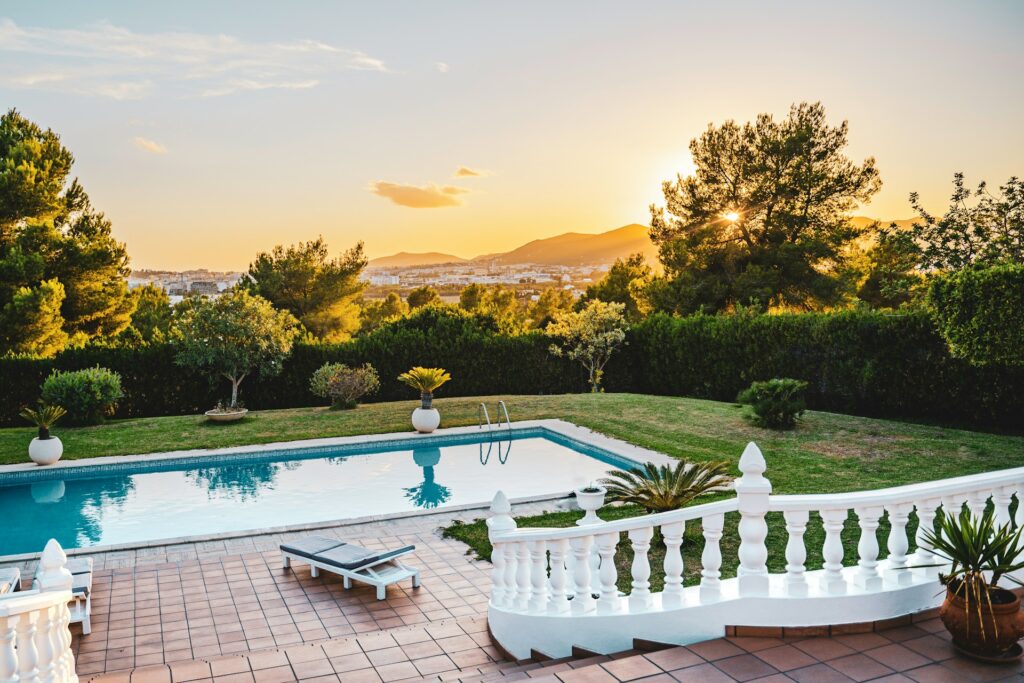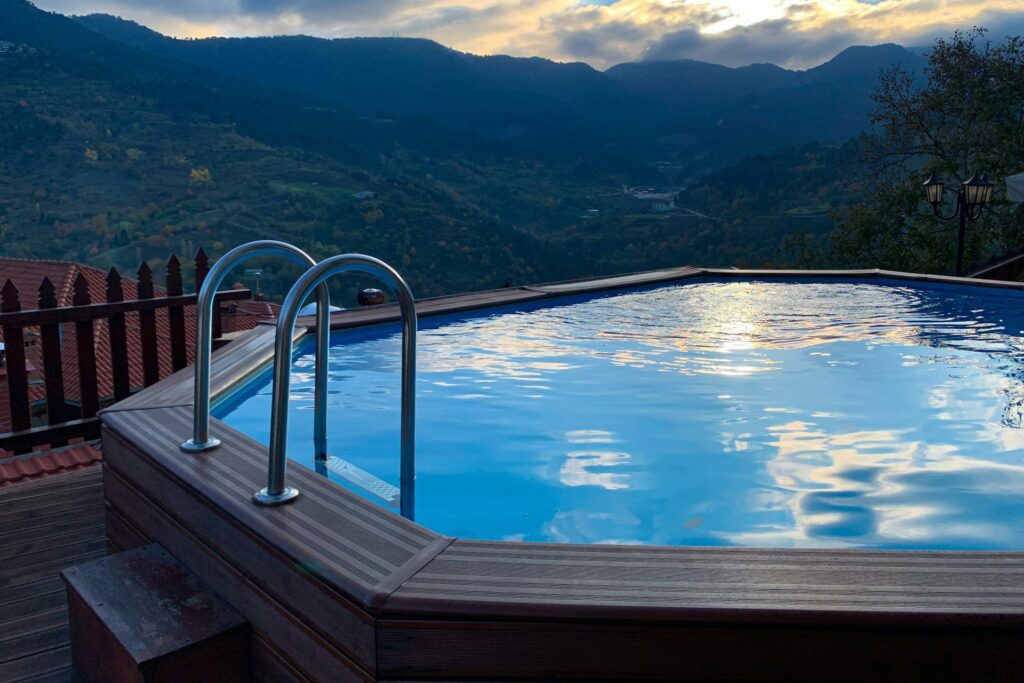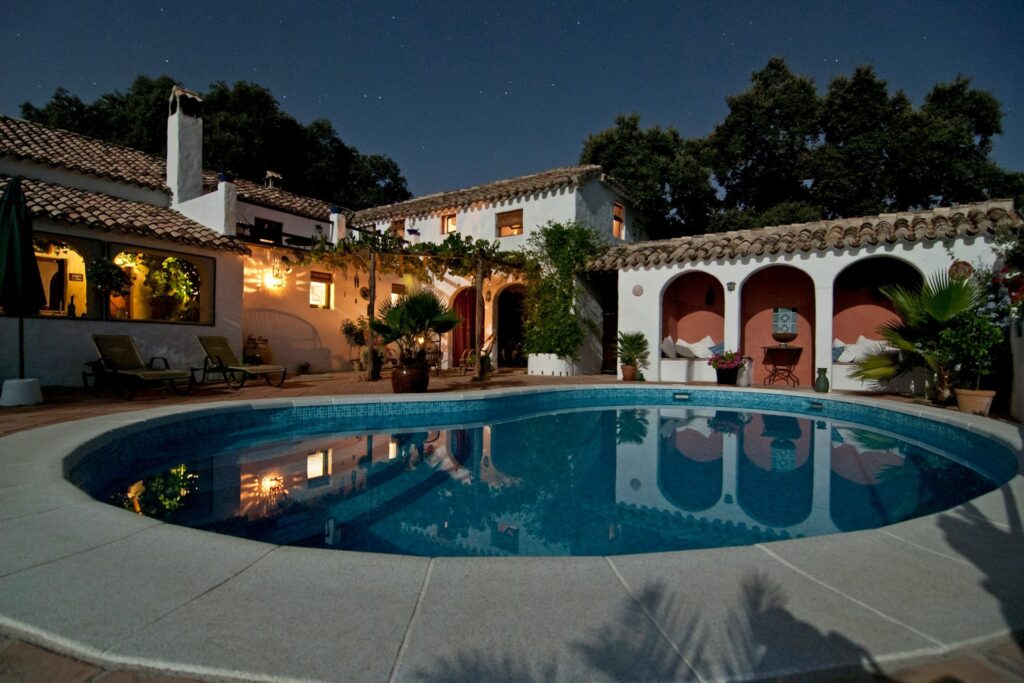
We are reader-supported. When you buy through links on our site, we may earn an affiliate commission.
Installing a pool is a great way to add value to your property and cool off when it’s hot out. It’ll also take a lot of work, time and money, so you should consider your options carefully. The biggest of these decisions is weighing an above-ground vs. inground pool.
When you think “swimming pool,” you likely picture an inground one, but above-ground options have plenty of advantages of their own. The best type depends on your specific situation and preferences, so it’s important to learn about both kinds before making your choice.

Inground Pool Basics
Inground pools are the most common type. As their name suggests, these are built into the ground, leaving the water’s surface relatively flush with the land around it.
There are three main types of inground pools, each using a different lining material. Concrete is the most popular, thanks to its durability and customizability, but it’s also the most expensive. Vinyl and fiberglass lining are cheaper but offer varying levels of personalization and longevity.
Because inground pools are essentially lined holes in the ground, you can make them in virtually any shape or size. This also means they’re permanent structures, and whether that’s beneficial depends on your long-term goals. As you might expect, installing an inground pool is a long, complex process, as it requires excavation.

Above-Ground Pool Basics
Above-ground pools, by contrast, sit on top of the ground, not in it. While they’re not as popular as inground options, they’re far from rare, especially in areas where pools as a whole are less common.
Like inground pools, above-ground pools come in a few different types. Some are temporary and stand alone, while others are more permanent and have decks or upper levels that make parts of them seem like an inground pool. They’re typically made of lighter materials like fiberglass, vinyl or aluminum.
As you might expect, above-ground pools have limited depth. They often come in four standard depths ranging from 42 to 54 inches. Similarly, you’ll have to choose from a limited number of sizes and shapes, as these are pre-made structures.
Above-Ground Pools vs. Inground Pools
Now that you understand the basics, it’s time to dive into the above-ground vs. inground pool debate. Even if you have a good idea of which style you prefer, it’s best to go over some important categories to see how each compares.
Costs
Apart from their appearance, the most noticeable difference between above-ground and inground pools is their cost. While both styles vary widely, inground pools are considerably more expensive than above-ground ones.
Installing an inground pool costs between $25,000 and $100,000 on average. Above-ground pools, by contrast, cost between $1,600 to $7,500 on average. That’s certainly not cheap, but it’s much more affordable.
Construction-related costs account for most of that difference. It typically takes a few thousand dollars to cover excavation alone for an inground pool. You also have to contend with ground inspections, leveling, permits and the added costs of a custom liner if you go that route. Above-ground pools share some of these expenses but generally require much less work.
Maintenance
Maintenance is another important factor to consider in the choice of above-ground pool vs. inground pool. While all pools need regular maintenance, some ongoing steps vary depending on the kind you have.
Because inground pools are typically larger, they often require more money and work to maintain. Even if you’re performing the same tasks, they’ll take less time on a shallower, smaller above-ground pool.
While inground pools may require more work for regular maintenance tasks, they’re less likely to need unexpected repairs. Inground pools are structurally stronger than above-ground ones, especially when you opt for a concrete pool. Consequently, they can withstand more wear and tear, which is particularly helpful if you have kids or pets or live in a storm-prone area.
Longevity
Longevity is a similar consideration. Pools cost a lot of money, so you’ll likely want to keep them for a long time to see a better return on your investment.
Inground pools win the longevity battle by far. A concrete swimming pool can last more than 50 years if you resurface it every decade. Even less expensive vinyl and fiberglass linings can last 15 to 30 years before needing relining.
Above-ground pools, by contrast, typically last between seven to 15 years. As a free-standing structure, time takes a greater toll on an above-ground pool, even with regular maintenance. However, that may not be a bad thing if you think you’ll move before that average life span is up.
Aesthetics
Your pool’s visual appeal matters, too. A pool can increase your home’s value by 7% in some cases, so a little attention to detail can go a long way.
Aesthetic appeal is largely a matter of personal taste, but many would agree inground pools often look better. Being flush with the ground makes them easy to cover when not in use without standing out. These pools can also fit more seamlessly into a greater variety of surroundings because they can be any shape or size.
That doesn’t mean above-ground pools lack curb appeal. However, they may take more surrounding work to look as sleek and dignified as an inground one.

Choosing the Right Kind of Pool for Your Home
With all these factors in mind, you can comfortably choose between above-ground pools vs. inground pools. In general, an inground pool will cost more but look better and last longer, while an above-ground pool will be more affordable but won’t hold up as well.
An inground pool is the best choice if you have enough cash to spend and plan to be in your current home for a long time. However, an above-ground pool may be better if you have less space to work with and may move in the next five to 10 years.
Remember to check with your local construction regulations, too. You may need to attain special permits for the digging required for an inground pool, while you can install an above-ground pool yourself with less disruption. Consequently, the latter may be best for particularly stringent neighborhoods.
The Best Type of Pool Depends on Your Needs
The battle of above-ground pool vs. inground pool is mostly a matter of preference and budget. Regardless of what you’re working with, you can find a type of pool that works for you. Start with this comparison to get a baseline idea of what you want and get the pool that fits your situation.







